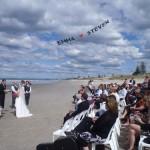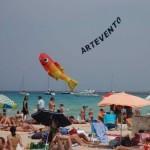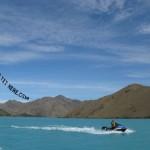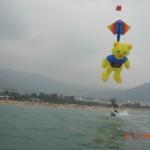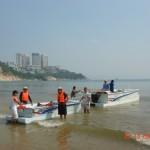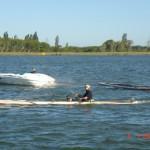Yes! We have Air Banners.-
An account of a kite flying journey that has taken some unexpected directions; being further evidence, if any is necessary, that ‘the foreseeable future’ is as mythical as steady mid range wind, government assistance, goat proof fences, and innocent bystanders (whoops, showing a few prejudices here).
The starting point was (as we’ve all no doubt pondered on): If kites could be flown exactly to a pre-determined timetable, then kite flying events would become really popular- perhaps even to the level enjoyed by more predictable activities such as, say, circuses, rock concerts and show trials (I was going to say public hangings instead of show trials but thought this might upset the squeamish, and I wouldn’t want to do this- oh goodness me no).
In the ’90’s I had the idea (as I’m sure others had before me) that kite shows could be done to a pre-determined schedule in many locations if a system could be developed to enable show kites to be launched, towed and retrieved from (small) boats.
Probably this was sparked initially by my frustration at tyro kite event organisers who put inordinate time and effort into planning detailed programs that take no account of the availability or otherwise of suitable wind. But it rapidly developed into dreams of choreographed kite shows with music, drama and a story line for captive paying audiences.
I had thought about developing something along these lines to take advantage of opportunities available during the Sydney Olympics (2000), but was distracted by various other projects (like kite buggying, kite sailing, kite boarding, mega kites and the increasing availability of half decent Australian reds).
And of course, I had seen the success of Bruce Flora/Kiteman Production’s theme park shows in Florida that use jet skis and ski boats to do kite displays. Bruce and crew launch their (usually stunt) kites by snatching them at speed from (generally) shore mounted frames- which works well for regular slots at theme parks but seemed to me to be unsuitable for the places and shows I had in mind.
It seemed to me that for practical on-the-water launching of kites from small boats, the key element is that modern kite flying convenience; the pilot kite.
The first attempt here to develop on-the-water launching (with help from Stefan Cook and Craig Hansen) was to build a floating trailer for Craig’s ski boat from which maxi kites could be launched and retrieved. Though rather cumbersome and not very portable, it worked, and in 2007 we set up and did a show this way at Shenzhen in China (using two boats linked together by a pole rather than a purpose built towed platform). There was almost no wind at the Shenzhen event that year so the kites we towed were almost the only ones flying- which impressed the organisers no end, a promising start.
By this time, the Al farsi family had offered support for this project, Paul Reynolds came aboard as business manager and Stefan as operations manager- and we had a name: UKS: “Ultimate Kite Show”.
Very soon we’d dispensed with the trailing platform and were launching show kites directly from the boat.
This was enabled by first launching a pilot kite (easy to do from a boat because wind speed is controllable), then accelerating until there was enough pull from the pilot to pop a bagged show kite up to flying altitude. When the bag is pulled off, the show kite inflates and flies. We then developed ways to do this with breakable ties (as are used when launching yacht spinnakers) instead of bags- and with experience, Stefan has found ways to reliably launch many styles of show kite (those with smooth tails and no drogues) without any special preparation except for ensuring that they leave the boat un-inflated and with their inflation point uppermost.
We trialed this at various events in 2008/2009; Shenzhen (again), San Vito de Capo (Sicily), Redcliffe (Australia), New Caledonia and at the Asian Beach Games in Bali. Although kite launching sometimes needed more than one attempt, with practice and more developed kites and equipment, near enough to 100% success is possible in a wide range of wind conditions (0 to 25knots at least).
But something was still missing: Yes, we could now launch, tow and retrieve show kites from boats, but could we get sufficient people to pay for this to make the development commercially viable before we ran out of time and money? By this stage, our dreams of becoming the kite version of Cirque de Soleil had become appended with ‘someday we hope’!.
One way to get some immediate business going was to add the ability to tow messages and advertising banners.
And this is when Stefan stepped up to the plate and hit a home run. During 2009 he developed a modular fabric letter system (patent applied for) from which required messages can be assembled in 30 minutes or less.
And then, during the 2009/2010 Christmas period, we (Paul Stefan and myself) decided to try fitting the launching and winch system to a jet ski instead of to the 5.5m runabout we’d been using as our test boat. This worked spectacularly well- and for the largely unanticipated reason that the phenomenal acceleration and manoeuvrability of jet skis makes launching kites and keeping them up through tight turns and in a wide range of wind conditions much easier. By mid 2010 we had a system developed (patent applied for) that enables reliable launching and retrieval of pilots kites , show kites and banners from a single operator jet ski while on the water. And we had a new name: “Air Banners” to reflect the changed focus.
It’s been a journey that has gone in directions I certainly didn’t anticipate 10 years ago, not least that it may yet be that the world changing idea in this is not the clever jet ski based kite launching and flying system at all- but Stefan’s modular letter banners- flown under kites (towed** or fixed tether), or from helium balloons or even from fixed structures.
We’ve only had our Air Banners website up for a week (and it’s still under construction) but there’s already strong interest from kite fliers who see opportunities to use their skills and contacts to lift letter banner messages at their local events- and for everything from proposing marriage to community services- and for the advertising market of course.
But this may just be the curtain raiser. Our jet ski based flying system does free kite fliers from the tyranny of wind, and I hope will one day lead to spectacular choreographed kite shows for vast appreciative audiences.
So many possibilities!- but one thing for sure is that the future will spring some surprises.
Thank you Paul, Stefan, Craig, Jenny, Abdul Rahman and Faris for making this journey possible.
Air Banners are at AirBanners.com
A starter pack of 105 letters (1.5m high) with line and pilot kite typically costs USD$2700 plus freight, duty and taxes. Watch our version of how Prince William may have proposed in Kenya.
Peter Lynn, Ashburton 30 Nov ’10.
*But pilot kites are not a modern invention at all. Wenham’s account of Pocock (1820’s kite pioneer from Bristol, England), quoted in Chanute states that “the charvolant or chariot was provided with a smaller pilot or upper kite which was sufficient to support the ‘Draft’ or lower kite when it was relaxed or allowed to float edgewise on the wind. ”
Once again therefore, a salute to George Pocock.
**Like by boat, jet ski, SUV, golf cart, ATV or snowmobile.

